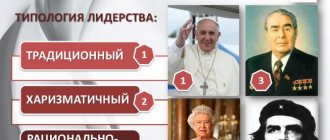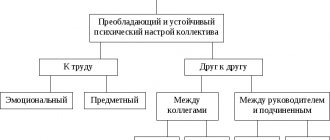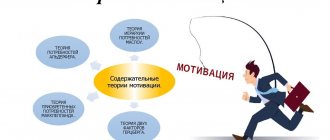.
The success of any organization depends on many factors. One of them is good management. Leadership in an organization determines the vector of the company’s development and encourages employees to work to achieve results. But the idea of the functions of a leader in a particular company is not fully defined. Even the person claiming this title often has little understanding of what is required of him.
Characteristics of a leader
A leader is a person who has a set of certain qualities that allow him to influence team members to achieve the goals of the organization.
The main qualities of a leader are:
- responsibility - the ability to complete undertaken obligations, to be responsible for their implementation;
- communication skills - the ability to find a common language with the company’s management and its employees;
- flexibility - the ability to quickly adapt to changing conditions in the organization;
- broad outlook and desire to constantly gain new knowledge;
- friendliness - the ability to build relationships with all team members, to be friendly;
- diligence - the desire to work under any circumstances;
- determination and perseverance - the ability to set goals and achieve them; Patience is the ability to wait for results.
Leaders in organizations become leaders in different ways:
- due to the presence of leadership abilities that a person initially has; through the active development of individual leadership qualities;
- due to a fortunate combination of circumstances that allowed him to prove himself and move forward.
In most cases, employees themselves choose from their circle a person suitable for the role of leader.
Subsequently, this person may be appointed to a leadership position.
Communication skills
If you are in a leadership role, good communication skills are absolutely essential.
The ability to build and maintain lasting relationships with people is extremely important for a leader.
A high level of communication skills is necessary to build business and personal connections, which are the key to further growth.
There is no development in isolation, so you cannot become a leader without the ability to find a common language with people of different social statuses and nationalities, political and religious views.
A sense of tact and diplomatic behavior helps to reach a compromise in the discussion of complex, controversial topics.
A true leader has a high level of emotional intelligence (EQ), which, according to some psychologists, is more important than the well-known IQ.
The ability to intuitively sense people’s moods and find an approach to them allows you to act appropriately to the situation.
The only way to get people to follow you is to make them feel heard.
Leaders attend various educational trainings, including those on the development of emotional intelligence. After all, it is important for a leader to be able not only to manage people, but also to manage himself! It is important to keep your emotions under control in order to calm down in time and make decisions with a cool head.
This is how communication skills turn out to be more important than the ability to take an integral and find the cosine of an angle.
Characteristics of leadership
Leadership is a complex process of influencing people to achieve organizational goals. There are several important signs of leadership:
- it is designed to influence employees to encourage them to be active;
- designed to make other employees want to work;
- focused on achieving a common goal that unites all team members;
- forms followers who can become independent leaders in the future;
- strives for self-organization within the team, streamlining all processes; sensitively captures the needs of those involved in the zone of influence.
leadership in a social group
Yakovlev A.M.
Leadership in a social group
Source: Social structure of society. Textbook. – M.: Publishing house “Exam”, 2003.
Chapter 9. Social communities and groups
9.3.Leadership in a social group
Any social group can be distinguished by its external structure (organizational form), within which its participants act in accordance with the purpose arising from the type of this or that social group, its tasks, goals, etc. Along with this, it is characteristic of a full-fledged social group that its internal, psychological structure, i.e. the views that characterize the members of this group, their attitude towards each other, complement the external structure of the group, contribute to its successful functioning. This structure is a network of psychological relationships and interdependencies. The individual elements of such a structure are the individual positions occupied by each individual in the process of his self-affirmation in the group. This structure includes separate small groups that unite individuals according to psychological characteristics.
Psychological structure is also expressed in certain types of relationships that arise between individuals in everyday communication. The psychological structure is derivative. Its formation is determined by a number of objective and subjective factors, but, once formed, it itself is a factor that has a huge impact on the individual. Because of this, it requires consideration, study and intervention.
The psychological structure of informal groups is characterized by a number of important features. In the course of constant interaction between individuals, their relationships begin to be ranked according to the degree of their importance for group members, intragroup relationships acquire a structure based on the degree of preference shown to each other by members of such a group. In each group, those to whom the group members give the greatest preference inevitably stand out from their environment.
The member of the group towards whom the greatest number of preferences is shown becomes the leader of the social group. At the other pole of the group structure are those (or that) in relation to whom (to whom) the smallest number of preferences are manifested (outcasts). This structure develops spontaneously, but once formed, it begins to largely determine the behavior of its members. The role of the leader of a social group acquires fundamental importance.
A central feature of leadership is the ability to influence the beliefs and activities of group members. The leader of a social group is one who initiates actions, gives orders, resolves disputes between its members and makes binding decisions on them. The leader approves or disapproves of the actions of group members, encourages or suppresses such actions. Members of a social group act, think and feel as the leader wishes, being influenced by him to a much greater extent than by the same influence of any other member of the group.
There are two types of leadership in small social groups: instrumental and expressive. An instrumental leader is necessary to organize a group striving to achieve a specific goal. Such a leader suggests an appropriate course of action and encourages group members to follow it. An expressive leader is necessary to achieve harmony and solidarity in relations between group members; he helps reduce the level of conflicts that arise between group members and maintains the level of group morality. Such a leader is attractive to group members and when a newly formed group nominates its leader (through a preference system), usually both roles
Leadership typology
There are different models of leadership in organizations. The division is carried out according to several criteria.
Depending on the influence mechanisms used, the following are distinguished:
- formal leadership - leaders become leaders by appointment, this concept is identical with official leadership, real power is in his hands, which he exercises within the framework of his powers, the impact on the team is carried out through disciplinary measures;
- informal leadership - influence on people is exerted not through administrative resources, but due to the personal characteristics of the leader.
By style of behavior there are:
- authoritarian - all management in the organization is concentrated in the hands of one person, who expects unquestioning obedience and execution of his orders; the initiative of other team members is not encouraged;
- democratic - involves the distribution of duties and responsibilities between all members of the team, communication ties within the team are developed, key decisions are made jointly;
- liberal - the leader delegates most of the powers to his followers, often withdrawing from solving assigned tasks, entrusting them to members of the team.
Depending on the personality characteristics of the leader:
- charismatic - the leader has abilities that he uses to organize the work of the team;
- situational, in which the leader can easily adapt to constant changes in the organization, can engage in reform, and is not afraid of innovative ideas;
- attributive, which involves building detailed cause-and-effect relationships, their analysis, an analytical mindset, and a tendency to painstaking and monotonous work.
Depending on the focus, leadership is divided into:
- aimed at people, in which the well-being of employees and their job satisfaction are put above all else, a lot of attention is paid to the psychological climate in the team;
- aimed at the interests of the organization, when all forces and means are aimed at achieving the set goals.
Functions and roles of a leader in a group
Functions of leaders.
As noted by Yu.N. Emelyanov19, the specificity of the leader’s functions is determined by the characteristics of the group he leads: in democratic groups, completely different functions are of decisive importance than in “authoritarian” ones. These functions are qualitatively different.
1.Leader as administrator
The most obvious role for the leader is the supreme coordinator of the group's activities. His responsibilities invariably include the function of monitoring execution. The essence of the administrative function is to assign work to other group members.
2.Leader as planner
The leader often assumes responsibility for developing the methods and means by which the group achieves its goals. This function includes both determining immediate steps and developing long-term action plans.
3.Leader as politician
Establishing goals and the main line of behavior of the group. Group goals and methods for achieving them have three sources:
Instructions from above, received by the group from the leader in accordance with the chain of command.
Indication below, i.e. decision of the group itself. Although the goals and means are determined from below, the leader is nevertheless responsible for their implementation, since he is also involved in the development of these goals and methods.
Directions from the leader himself.
Thus, regardless of the source, defining group goals and methods for achieving them is an essential function of the leader.
4.Leader as expert
In almost all cases where group members depend on a person whose technical knowledge and skills are necessary to achieve group goals, there is a polarization of power around that person, which he can use to strengthen his leadership role.
5. Leader as a representative of the group in the external environment.
The leader is the official person of the group, speaking in the external environment on behalf of everyone. The leader identifies all members of the group, their collective mind, will, etc. it transforms information coming from the group and received for the group. The leader as a regulator of relations within the group. The regulation of personal and business relationships within the group is carried out through a communication network, which can take different forms.
In some groups, all information passes through the leader; sometimes there are people in the group close to the leader who close this network on themselves; There is a type of group where the leader is also one of everyone.
6.Leader as a source of rewards and punishments
The leader uses this function to monitor the activities of group members. She places high demands on the personal qualities of a leader. The leader has in his hands the means by which he can reduce or maintain the tendency towards factionalism within the group, depending on what his personal plans are.
7.Leader as an example
The leader can serve as a model of behavior for the rest of the group, i.e. provides them with a clear indication of who they should be and what they should do.
8.Leader as a symbol of the group
Groups with a high degree of cohesion strive not only for internal, but also external differences from other individuals. The leaders of such groups begin to serve as symbols: their names are assigned to the entire movement.
9.Leader as a guide to worldview.
The leader serves as the source of the values and norms that make up the group's worldview. It reflects the ideology of the society to which the group belongs.
10. The leader as a factor that cancels individual responsibility.
The leader plays an important role for group members in freeing them from responsibility for personal decisions and actions that they would like to avoid. Thus, in response to the follower's devotion, the leader takes the trouble to make decisions for him.
11. A leader is like a “father.”
The multiple functions of the leader are integrated into the overarching role of "father" to group members. A true leader is the focus of all positive emotions of group members, the ideal object of identification and feelings of devotion.
12. The leader is “as a scapegoat.”
The leader can serve as a target for aggression from group members in case of failure. A special case is when group members lose illusions about the real goals or personality of the leader. That is why ideological opponents so persistently search for facts that discredit the leader of a hostile group.
Group members may have a shared, established opinion about how a leader should behave and what functions he should perform. And they will only select and retain leaders who meet their expectations.
Two functions of a leader: the elimination of individual responsibility and the symbolization of the father - assume that the one who is able to satisfy such needs of the individual as the need to rely on someone, to become close to someone, etc. will be chosen as a leader.
The role of leadership in an organization
The role of leadership is difficult to overestimate; without it, an organization is doomed to stagnation at best, and to cease to exist at worst. Leadership coordinates all processes occurring within and directs them in the most favorable direction for everyone. It often has a more effective impact on employees than a clearly organized vertical of power in the company.
The leader fully participates in the functioning of the organization, setting goals, formulating tasks, and finding ways to solve them.
Sometimes, from the leadership side, the true needs of the organization are seen from a different perspective, which allows them to be satisfied faster.
Unites managers and subordinates, encouraging them to concentrate efforts to solve common problems. It is possible that it will be difficult for both sides; leadership influence should smooth out all the rough edges, find compromises, help avoid conflicts or find the right ways out of conflict situations.
Actively participates in personnel selection. The success and advancement of the organization depends on this, so an informal assessment of a potential employee benefits all parties in the work process.
Leadership is intrinsically linked to corporate culture. It forms and develops it, creates and maintains corporate values in the team.
Leadership roles are not always clearly regulated; they can be expressed in spontaneously organized measures of support, positive influence, inspiration for new achievements, and de-escalation of the work environment. The mood of employees is one of the main forces that allows them to cope with difficulties and achieve their goals.
The problem of leadership in a team. Main types of leaders
Leadership, like management, is to some extent an art. To this day, questions about leadership remain relevant, since no clear and definite answers have yet been given. But the various models and theories discussed in this work help to recognize the need for a flexible approach to leadership.
The team is a powerful incentive for work activity, which brings satisfaction to its members, sets high goals, and creates a creative atmosphere. Joint resolution of production issues reduces stressful situations and increases the innovative potential of employees; in a group, related problems are better solved, the possible consequences of an unclear distribution of responsibilities and improper leadership, and conflicts at the interpersonal level are smoothed out [2; 4; 9].
A leader is a member of the group, whom the group members themselves recognize as the priority of making responsible decisions in important circumstances. A leader is an authoritative person who plays a central role in organizing joint activities and regulates relationships in the group. The organization of the group, its composition, the desire to work and achieve goals depend on it. The stronger and more responsible the leader, the stronger the group will be [3; 5].
Like all group members, a potential leader strives to achieve group goals and at the same time has some additional needs of his own. What sets a future leader apart is that these additional needs can best be met by accepting a role. Depending on the degree of awareness of his needs and value orientations, the future leader can purposefully seek a leading role, or this process can occur spontaneously; or rather, his followers are engaged in his nomination, making sure that he has the sum of the necessary qualities.
A leader is, first of all, a person. And, in order to understand what kind of work he wants to do with the help of his team, what he can give to his people, you need to understand what kind of person he is, and which of him is the leader in practice [6; 7].
In Russian psychology, there are five types of leaders [1; 8; eleven].
- Leader-organizer. His main difference is that he perceives the needs of the team as his own and actively acts accordingly. He is optimistic and confident that most problems can be solved. He knows how to convince, is inclined to encourage, and if it is necessary to express his disapproval, he does so without hurting someone else’s personal dignity. They follow him, knowing that he will not offer an empty deal. These are the people who are visible in any informal group.
- Leader-creator. Attracts one, first of all, by the ability to see new things, to take on problems that may seem insoluble and even dangerous. He does not command, but only invites to discuss a problem or ways to solve a problem, and can pose it in such a way that it will interest and attract subordinates.
- Leader-fighter. A strong-willed, self-confident person. He is the first to face danger or the unknown, without hesitation he enters into a fight against factors that interfere with his subordinates, he is ready to defend what he believes in and is not inclined to make concessions. However, such a leader sometimes does not have enough time to think through all his actions and foresee everything. “The madness of the brave” is his leadership style.
- Leader-diplomat. If he used his abilities for evil, then he could well be called a master of intrigue. He relies on excellent knowledge of the situation and its hidden details, is aware of gossip and gossip, and therefore knows well who can be influenced and how. Prefers confidential meetings in a circle of like-minded people from among his subordinates. Allows you to openly say what everyone knows in order to divert attention from your unpublicized plans. True, in a work collective, this kind of “diplomacy” often only compensates for the inability to lead in more dignified ways.
- Leader-comforter. You reach out to him because he is ready to support you in difficult times. Respects people and treats them kindly. Polite, helpful, capable of empathy.
Political leadership is also distinguished [10; 12].
- The leader-standard-bearer - the leader sees reality in a special way. He represents the ideal leader for the masses. People follow the path marked by him with great pleasure.
- Servant leader—focuses on the wants and needs of his people. Always acts on behalf of his constituents.
- A sales leader is a leader who is able to profitably “sell” his ideas. Voters immediately see the advantage of a given candidate over others.
- A leader-firefighter - he is focused on the pressing and urgent problems of the masses. This leader is always ready to solve specific situations, once he knows about them.
There are usually no pure images among leaders. Each leader combines 2-3 characteristics at the same time, but in different proportions. Thus, the typology of leadership given above cannot apply in its pure form to any specific person.
The role of a leader is the ability to lead people, to ensure the existence of such connections in the system of interpersonal relationships that would contribute to the solution of specific tasks within the framework of a single goal.
There are quite a lot of problems in terms of management, but summarizing them, we can highlight one, the main problem of any leader, both beginner and “veteran”. This is, of course, a way to generalize the team, give them a common goal and ensure that further work does not lead to disagreement. And the “rule” of the leader himself was not questioned or challenged. A bad leader never stays in charge for long; he is quickly replaced by another. A team or a group of people needs a reliable leader who works for them, who, despite everything, will help and will not leave them in trouble [13].
Leadership is a complex matter that requires constant attention. It cannot be postponed, but must be improved every time.
And we can say that a leader cannot afford to use the same leadership style in different situations. Those. a leader must skillfully use all leadership styles, focusing on reality, which confirms the statement that leadership is an art.
Leadership, power, management
Leadership, power and management are close, but not identical concepts. Power is associated with leadership and is always directed from top to bottom. Leadership can come from below and span all layers of the organization. It can merge with power, possess its features, partially use its methods, but it tries never to use external force.
Management is a management system that implements the tasks set by the management of the organization.
Managers act according to established plans and schedules. Manager's tasks: fulfill instructions, achieve certain indicators. They act out of necessity, not out of their own desires. Management uses effective leverage over employees and exercises control over all processes.
Who is a leader?
Many people mistakenly believe that a leader is primarily someone who simply manages other people.
But this formulation is considered not entirely correct, and is more suitable for the description of a related concept - “boss”. The meaning of leadership is not focused on the management position, since the main goal here is to find a balance between the personal needs of employees and the interests of the entire company. As a boss, this is easier to achieve if you use strategic thinking, but not every company director will be considered a leader by default.
A leader is a specific person in a team or other group of people who enjoys recognized authority and has a certain influence that is reflected in the behavior of other people.
It is the implementation of the mentioned key compromises that distinguishes the leader from the rest of the team members. Moreover, there is no reason to generalize all the qualities inherent in such people into a single image, because in practice, the ability to give orders and expect their execution is based on various qualities.
Depending on the methods of influence used, the types of leaders can be classified as traditional (based on habit), rational-legal (based on reason) and charismatic (referring to faith and emotions) models.
Traditional leadership is usually based on historical facts and rituals. One of the most ancient habits of mankind - submission - is based on the belief in the rule of transfer of power by inheritance. It turns out that a potential leader acquires the legal right to dominance due to his origin (leaders, elders and monarchs).
Rational-legal leadership is based on a completely different, more liberal scheme, where there is a reasonable algorithm for electing a new leader, as well as the transfer of clearly limited powers. Such power is often based on a set of legal acts that were previously recognized by the entire society.
Charismatic leadership is based on belief in the exceptional qualities of a particular individual and his unique tactics. Individual traits of a person rarely play a decisive role here: the real abilities of the leader and the qualities that those around him and devoted followers (like F. Castro or I. Stalin) are of much more value.
In any case, we can safely say that the future lies behind the leadership style of management. This type of control can save resources, make the business more competitive, achieve long-term goals, unite the team and even prevent staff turnover: so many positive results thanks to one person!
Unlike an ordinary boss, who is obliged to lead because it is his job, a leader manages for the sake of a successful outcome. He focuses as much as possible on the result and is responsible for the consequences under any circumstances. However, one should not confuse a leader with a nanny. Along with the assigned tasks, he transfers to his wards responsibility for their own actions. His main function is to suggest and guide, but not to do everything himself or teach basic things.
A good leader will never blame external circumstances (economy, politics, market) or other people in case of force majeure and serious failures. But even after the successful ending, he will begin to attribute the main achievements not to himself, but to the whole team. Perhaps this is one of the few reasons why it is so difficult to be a leader - few people are ready to sincerely make such a self-sacrifice.
Leadership management in an organization
Managing an organization's leadership includes several important elements:
- Actions aimed at identifying leaders in the organization. It is necessary to find those who already have a sufficient set of knowledge and skills or are potentially ready to develop them in themselves.
- Establishing interaction with employees in order to find out their needs, wishes, and provide motivation.
- Creating conditions for deepening and developing leadership skills.
- Provide opportunities to receive additional education and deepen knowledge.
Factor-analytical and situational theories of leadership
Represents the second wave in the development of trait theory. Individual qualities and characteristic behavior in achieving goals, which may differ, are highlighted. For example, a gentle and kind person, being a leader in the army develops confidence, rigor, and determination. This concept introduces concepts such as tasks and goals that are related to a specific situation into leadership theory. A leader’s behavioral style is formed as a result of the interaction of his personal qualities and assigned tasks, and depends on social conditions. T. Hilton, R. Strogdill, A. Goldier wrote about this in the situational concept, believing that a leader is a function of a specific situation, and that under other conditions this leader may no longer be one. That is, specific circumstances select a leader and determine his behavior.
In such a situation, leadership qualities are relative, but in general they are distinguished by confidence, determination, competence, and willingness to take responsibility. This theory has a drawback; it does not fully reflect the leader’s activity, his ability to make decisions when conditions change, considering the role of the situation as leading in the formation of leadership. E. Hartley supplemented the situational theory, revealing the nature of this phenomenon:
- if a person has become a leader in one situation, this increases his chances of becoming a leader under other conditions;
- a person gains authority by becoming a leader under certain conditions, which contributes to his election to a leadership role and consolidation of leadership;
- a person who has become a leader, due to stereotypical thinking, is perceived as a leader in principle;
- leaders become people who have appropriate motivation.
Note 2
There is a concept of situational effective leadership, which explains the use of different leadership styles depending on the situation. Has nothing to do with leadership.









